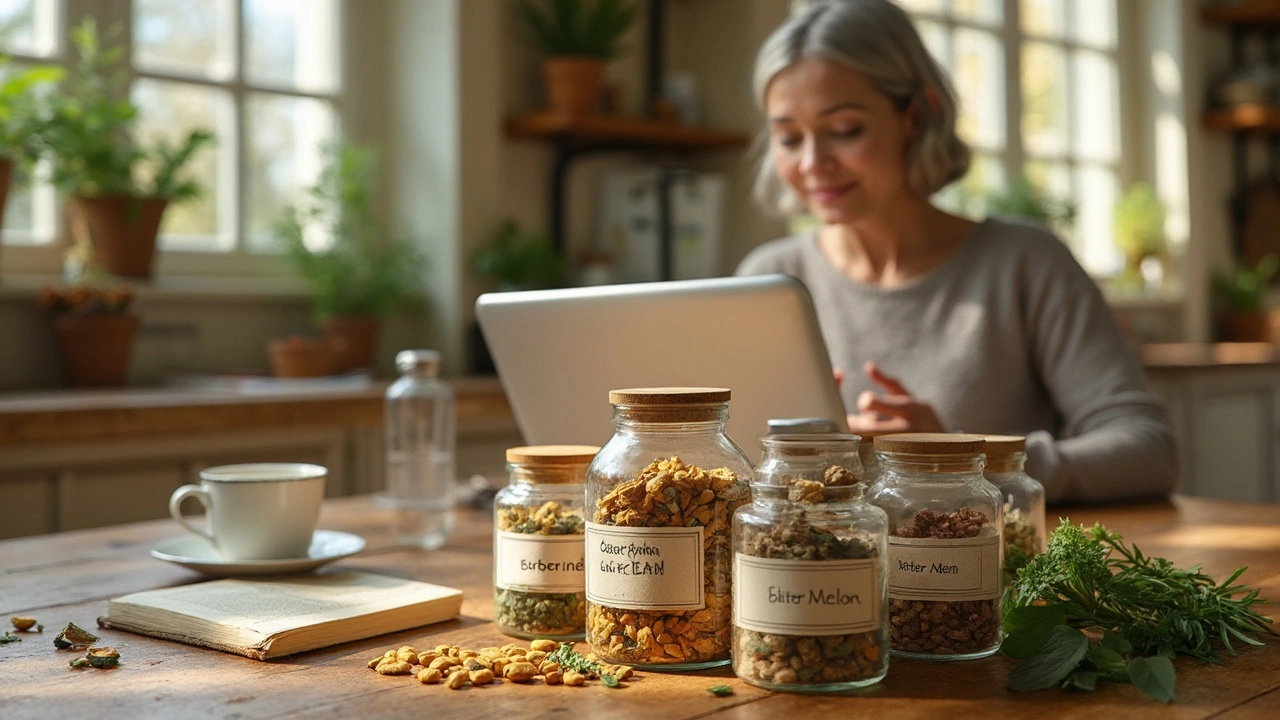Why People Are Turning to Plants: The Surprising story of Metformin Mimics
It’s wild to think about how a century ago, the main tools for blood sugar support were simple herbal teas and old family recipes. Now, metformin—a little white tablet—is the global front-runner for type 2 diabetes. But here’s the kicker: metformin’s story actually starts with a plant, French lilac (Galega officinalis). That’s right: the roots of modern medicine are tangled up with old-school herbal wisdom. So, it’s not that shocking that a wave of Aussies (and plenty of people everywhere) are hunting for herbal supplements that have similar blood sugar effects. It’s not just about wanting something “natural”—there’s cost, side effects (hello, unpredictable gut issues), and the simple curiosity to see what non-pharma options can offer.
Here in Brisbane, with the kids and Max zipping around the backyard, I see more folks swapping tips on new botanicals than asking about prescriptions. My pharmacist mate told me last month that out of the people walking in for a diabetes script, a third are curious about what herbs “actually work like metformin.” And that’s not hype. The global herbal supplement market for blood sugar has ballooned—worth over $3.5 billion in 2024, led by Australia, the US, and Germany. Meanwhile, doctors warn: don’t toss your meds or change routines without a proper talk first. But what’s catching everyone’s attention? Two names come up almost every time: berberine and bitter melon. Let’s break down the facts on these, and see what else is moving the needle.
Berberine: The Star Herbal Metformin Alternative?
Say “herbal metformin” to anyone tracking wellness trends, and they’ll blurt out “berberine!” before you finish. Berberine is a compound found in several plants—barberry, goldenseal, and tree turmeric, to name a few—and it’s been used in Chinese and Ayurvedic medicine for centuries. But for most people here, what matters is this: does berberine really work as well as folks online claim?
There’s a hefty pile of studies, and a meta-analysis in the journal Metabolism in 2022 found that berberine can reduce fasting blood glucose by about 1mmol/L on average—similar to what you’d expect from starting dose metformin. In fact, one quote from a 2023 review in the Journal of Ethnopharmacology sums it up:
"Berberine’s effect on glycemic control may approach that of standard pharmaceuticals, yet it requires further large-scale trials before firm conclusions."This doesn’t mean you can treat berberine as an exact substitute, but it does support the idea that the effects aren’t just Internet hype. The cool part is how it works: berberine seems to boost a molecule called AMPK, just like metformin. That tells the cells to use glucose better, drop insulin resistance, and lower liver sugar production. Some researchers even call it “nature’s metformin.”
But is berberine safe? For most healthy adults, the usual dose—500 mg two or three times a day—comes with mild gut complaints if anything (think soft stools, or a bit of cramping) and little else. Pregnant mums and young kids should skip it (safety data’s lacking). A lot of Aussie brands now stock it, but no two are created equal—watch out for knockoffs. Chat to a doctor if you’re on blood thinners, as berberine may interact.
One tip for real life: take berberine about half an hour before meals for best results. Don’t expect magic in a week. Most people see stable effects over 8-12 weeks, according to local nutritionists. And no, don’t try doubling or tripling the dose for “extra” benefits. It doesn’t work like that, and your guts will not thank you.
Fun fact: A 2024 Australian online survey of 600 people taking berberine showed that 60% had heard about it from a friend—not their doctor. That’s telling you something about how community buzz is outpacing clinic advice on this one.

Bitter Melon: The Forgotten Fruit for Blood Sugar Control
This knobbly green gourd might remind you of a cross between a zucchini and that one weird cucumber you accidentally left to rot in the crisper. But bitter melon (Momordica charantia) is a superstar in Asia, Africa, and the Pacific Islands for anyone managing blood sugar. Here in Brisbane’s Asian grocers, it’s cheap, fresh and more popular each year. What sets bitter melon apart from berberine? It’s both food and medicine, and you can use it in a salad, stir-fry, or as a capsule.
The science? There’s good news. In a randomized trial out of Malaysia in 2021, people with prediabetes who ate 200g of cooked bitter melon daily for 12 weeks dropped their HbA1c by 0.65%—not far from a low-dose metformin group. Bitter melon works by activating insulin receptors and improving glucose uptake in muscles. The plant contains compounds like charantin and polypeptide-p, both of which have an “insulin-like” effect.
But let’s talk taste. Bitter melon lives up to the name. You can mask it in a curry or juice it with orange and ginger to soften the hit. If food’s not your thing, capsules and teas are everywhere now. Max sniffed at some sliced bitter melon on the counter this morning—he looked confused. If Max won’t eat it, you know it’s got punch.
Another perk? Bitter melon is nutrient-dense: loaded with vitamin C, A, and potassium. My mate’s mum swears by a trick: soak the fruit slices in water with a dash of salt to pull out extra bitterness before stir-frying. Real-world, you’ve got to stick with it—no overnight miracle. People often notice lower fasting sugar in a few weeks, as per a 2023 study run in Sydney with 80 participants, but results vary.
As for safety: too much can cause tummy upset, and rare cases of low blood sugar if you’re combining with drugs like insulin. Pregnant and breastfeeding women shouldn’t use it. Worried about allergies? Always try a small amount and see how you go.
Other Botanicals Worth Watching For Insulin Sensitivity
Sure, berberine and bitter melon grab most of the headlines, but the plant world’s packed with hopefuls for anyone looking for metformin alternatives. Cinnamon, gymnema sylvestre, and fenugreek all have traditional uses for blood sugar. But how do they stack up in the real world?
Cinnamon isn’t just for spicing up your porridge or coffee. Double-blind trials from 2023 out of the University of Queensland showed cassia cinnamon (the common kind here) can trim fasting glucose by about 0.3–0.5 mmol/L when used daily (1–2 grams in food or capsules). That’s helpful, if milder than berberine. The key is consistency: sprinkle some in tea, yoghurt, or smoothies, or chase a daily capsule. Anything over 4 grams daily could affect your liver, though, so don’t get carried away.
Cue the new wave of gym-based dieters: there’s gymnema sylvestre, a woody climbing plant dubbed the “sugar destroyer.” It can block sweet taste and cut sugar cravings, and a 2022 clinical trial found a gymnema supplement (400 mg twice a day) helped overweight volunteers drop both fasting sugar and snack cravings inside three months. There are gymnema teas and capsules, but most people say the leaf powder tastes “like grass after rain.” Worth adding to blends, not alone.
Fenugreek’s been in the spotlight thanks to Indian and Middle Eastern kitchens. It’s a powerhouse for fibre, and two tablespoons of soaked seeds a day can slow sugar spikes after meals. There’s a bonus: regular fenugreek use can benefit cholesterol. But just be ready—fenugreek gives sweat and pee a distinct maple syrup smell. Not dangerous, but a surprise the first time.
Other hopefuls? Mulberry, holy basil (tulsi), turmeric, and even green tea extract are gathering evidence, though most have milder effects on their own. Some people mix and match for a multi-herb approach. Always let your doctor know what you’re mixing, especially if you’re juggling scripts.
- Bitter melon and berberine hit with the biggest bang for most folks looking for a “natural metformin.”
- Cinnamon and gymnema offer moderate, real-world effects, especially combined with diet.
- Fenugreek earns bonus points for fibre and cholesterol.
But here’s a head’s up for every dad, mum, or mate curious about these herbs: start with one, keep notes on how you feel, and never ditch real medicine on a whim. Herbs are powerful, but they aren’t magic bullets, and everyone’s body reacts differently.

Simple Ways to Put Plant-Based Metformin Alternatives Into Your Routine
After endless chats at backyard barbies, in the school carpark, and at my local chemist, I noticed the same question popping up: “How do you actually work these herbs into normal, chaotic Aussie life—without it becoming another chore?” Good news: it’s all about being practical and consistent, not perfect.
| Herbal Supplement | Typical Daily Dose | Common Forms | Probable Benefits | Main Side Effects |
|---|---|---|---|---|
| Berberine | 1000-1500mg | Capsules, tablets | Lower glucose, improved insulin sensitivity | Gut upset, cramps |
| Bitter Melon | 200-300g fruit or 1000mg extract | Fresh, tea, capsules | Lower fasting blood sugar | Bitter taste, rare low sugar |
| Cinnamon | 1-2g powder | Spice, capsules | Mild sugar lowering | Liver stress (in excess) |
| Gymnema | 400-800mg | Tea, extract, capsules | Cut sugar cravings | Loose stools (high dose) |
| Fenugreek | 5-10g soaked seed | Whole, capsules | Slow sugar spike post-meals | Maple scent, bloating |
If you’re starting out, try berberine capsules with your main meals, or toss fresh bitter melon into a veggie stir-fry twice a week and see how you feel. For cinnamon, just add it to Greek yoghurt, smoothies, or overnight oats five days out of seven. Want a deeper dive into what combinations work and how to structure your approach? Check this guide for natural alternatives to metformin. It covers more strategies—both pharmaceutical and herbal—to mix and match safely and sensibly.
Last tip: cells love movement. You’ll get more out of any herbal plan by pairing these botanicals with a short walk after dinner or bursts of activity (biking with your kids, playing fetch with your golden retriever). Plenty of local GPs tell me their “non-medicine clients” have the best results when they focus on both herbs and simple, steady lifestyle tweaks—less stress, a little morning sun, and sleep in a cool room.







Nicole Povelikin
July 18, 2025 AT 14:33Honestly, I don't buy into all those herbal hype pieces. Like, sure, berberine might kinda help with blood sugar, but it ain't metformin. People gotta stop treating nature like some magic pill factory. There's always side effects and interactions they don't mention upfront.
Plus, why assume these botanicals are safer just 'cause they're natural? Bitter melon isn't candy, it has a bitter kick and can mess with other meds. I'd rather know everything before trying to swap real medicine with some trendy leaf.
Anyone else think these 'natural solutions' articles are selling more hope than facts?
John Keough
July 19, 2025 AT 07:40This article really piqued my curiosity! I've been exploring alternatives to metformin due to some side effects I've experienced. It's reassuring to see some science backing herbs like berberine. However, I'm curious about the scale of efficacy compared to prescribed meds.
Does anyone have firsthand experience combining these supplements with traditional treatments? I'm also interested in how dosage and timing affect insulin sensitivity when using these botanicals.
Looking forward to hearing thoughts before I make any changes.
Graham Smith
July 20, 2025 AT 04:40I noticed quite a few typos and some loose grammar in the article, which undermines its credibility. For a topic that affects so many, accuracy should be paramount.
Nonetheless, the detailed breakdown on berberine and bitter melon’s mechanisms was informative. I’d urge the author or readers to double-check clinical references to avoid the spread of misinformation.
Jeremiah Morgan
July 21, 2025 AT 00:33I'm genuinely optimistic about how natural supplements might empower individuals to enhance their health. That said, it remains essential to exercise caution and consult healthcare professionals before substituting medications.
Metformin has a robust history of clinical testing, whereas botanicals like bitter melon might vary substantially depending on sourcing and preparation.
Still, integrating these natural items as complementary options could be beneficial if handled prudently.
I’d be interested in community feedback regarding monitored results during such transitions.
nina greer
July 21, 2025 AT 20:26These botanicals trend for one reason: they sound chic and natural. Does their effectiveness hold up? Skeptical. People should prioritize science over buzzwords.
Montague Tilmen
July 22, 2025 AT 16:20Enough with this wishy-washy natural supplement nonsense. If you want results, you take what works, prescribed by your doctor. The herbal market is a circus full of charlatans preying on naive folks.
We don't have time to waste experimenting on dubious botanicals when real medication is out there.
Clarise Wheller
July 23, 2025 AT 12:13This piece offers a balanced insight on herbal supplements, which is quite refreshing. I appreciate that it didn't sugarcoat potential side effects, making it respectful to cautious readers.
Including practical daily tips makes the information actionable rather than just theoretical.
Anyone here tried integrating these botanicals while under medical supervision? How was that experience?
Riley Fox
July 24, 2025 AT 08:06Well, well, the eternal dance between synthetic pills and so-called natural remedies! ;-) However, we mustn't be fooled by baseless allure. Berberine and bitter melon might possess qualities that challenge our pharmaceutical titans, but skepticism is a virtue here.
Isn't it fascinating how the body responds to botanical compounds? Yet, does nostalgia for nature trump rigorous testing?
Enjoying the discussion, folks! Keep questioning and keep learning :)
David Stephen
July 25, 2025 AT 04:00For those considering these supplements, I urge a careful approach. Scientific evidence varies, and responses differ individually.
It's important to approach any regimen change thoughtfully and with professional guidance to avoid unintended complications.
Optimizing insulin sensitivity is a journey, not a shortcut.
Roberta Giaimo
July 25, 2025 AT 23:53Great read! 😊 It's refreshing how the article clearly outlines both benefits and risks without overpromising. The talk on dosing tips was especially helpful, as many people overlook that.
Hope more folks remember to check with their doctors and keep track of any changes when trying new supplements!
Tom Druyts
July 26, 2025 AT 19:46Hey all! I’ve been using berberine for about six months now, alongside my prescribed meds. I noticed a gradual improvement in my blood sugar levels and energy.
The article’s suggestions about timing (before meals) really helped me maximize the benefits.
I always keep my healthcare provider informed, and so far, no adverse effects.
Does anyone know if combining bitter melon with berberine offers synergistic effects? Would love to hear experiences or studies about that!
John Keough
July 27, 2025 AT 15:40@332 Thanks for sharing your experience! That's exactly the kind of real-world feedback I was hoping to find. The synergy question is interesting; combining phytochemicals could amplify effects or cause unexpected problems.
Have you or your doctor monitored any particular markers to track progress or side effects more closely?